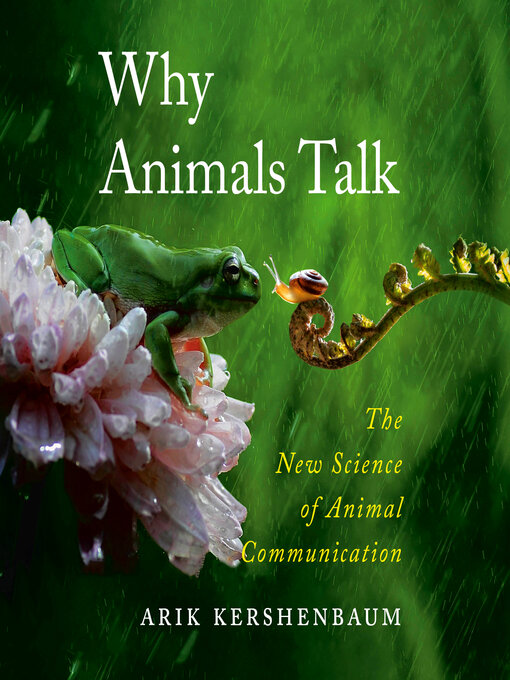Why Animals Talk
The New Science of Animal Communication
From leading zoologist Arik Kershenbaum, a delightful and groundbreaking exploration of animal communication and its true meaning
Animal communication has forever seemed intelligible. We are surrounded by animals and the cacophony of sounds that they make—from the chirping of songbirds to the growls of lions on the savanna—but we have yet to fully understand why animals communicate the way they do. What are they saying? This is only part of the mystery. To go deeper, we must also ask, what is motivating them?
Why Animals Talk is an exhilarating journey through the untamed world of animal communication. Following his international bestseller, The Zoologist’s Guide to the Galaxy, acclaimed zoologist Arik Kershenbaum draws on extensive original research to reveal how many of the animal kingdom’s most seemingly confusing or untranslatable signals are in fact logical and consistent—and not that different from our own. His fascinating deep dive into this timeless subject overturns decades of conventional wisdom, inviting readers to experience for the first time communication through the minds of animals themselves.
From the majestic howls of wolves and the enchanting chatter of parrots to the melodic clicks of dolphins and the spirited grunts of chimpanzees, these often strange expressions are far from mere noise. In fact, they hold secrets that we are just beginning to decipher. It’s one of the oldest mysteries that has haunted Homo sapiens for hundreds of thousands of years: Are animals talking just like us, or are we the only animals on the planet to have our own language?
* This audiobook edition contains a downloadable PDF with charts and pictures.
-
Creators
-
Publisher
-
Release date
August 6, 2024 -
Formats
-
OverDrive Listen audiobook
- ISBN: 9780593864685
- File size: 249898 KB
- Duration: 08:40:36
-
-
Languages
- English
-
Reviews
-
Publisher's Weekly
June 3, 2024
In this rewarding study, Cambridge University zoologist Kershenbaum (The Zoologist’s Guide to the Galaxy) examines the meaning behind howls, screeches, and other calls of the wild. He explains that wolf howls can be heard over 10 kilometers away and help pack members keep in touch with one another while alerting outsiders that they’re in another pack’s territory. Each dolphin develops its own “signature whistle” to identify itself to others, Kershenbaum writes, noting that dolphins get excited when they hear the whistle of another dolphin they haven’t seen in a long time. Recounting his own work with African gray parrots at a Canary Islands zoo, Kershenbaum describes how male rivals attempt to establish social dominance by copying and embellishing one another’s calls in a “kind of avian dueling banjos.” Elsewhere, Kershenbaum discusses how gibbon couples bond by rehearsing complex vocal duets, and how male hyraxes (rabbit-like mammals) signal their strength by “singing,” hoping to intimidate other males who may pose competition for mates. The captivating science highlights the complexity of animal calls, and Kershenbaum takes pains not to overstate the findings, stressing that humans are likely the only species capable of understanding grammar. Animal lovers will want to give this a spin. Photos. -
Library Journal
Starred review from December 6, 2024
Zoologist Kershenbaum's (The Zoologist's Guide to the Galaxy) scientific look at the communication of animals covers not how they speak but instead why animals communicate. Quite a range of creatures are represented here: parrots, dolphins, wolves, and humans, with information gathered from studies done by institutions and from observations by the author. John Hastings's narration will remind listeners of a college lecture. Normally this might be off-putting, but because of the combination of subject matter and writing, the audio style instead fits well and adds to the content. Listeners of the audiobook also get to hear examples of different styles of animal communication, with the clips playing between the sections of narration at the appropriate points. VERDICT A surprisingly interesting take on a subject matter that has been examined many times before. The audio's ability to add so much more experience of the subject matter makes listening to the book a much better experience than reading it. This excellent addition is a fun lecture that changes the way listeners will look at (and hear) animals.--Richard Winters
Copyright 2024 Library Journal, LLC Used with permission.
-
Loading
Why is availability limited?
×Availability can change throughout the month based on the library's budget. You can still place a hold on the title, and your hold will be automatically filled as soon as the title is available again.
The Kindle Book format for this title is not supported on:
×Read-along ebook
×The OverDrive Read format of this ebook has professional narration that plays while you read in your browser. Learn more here.


